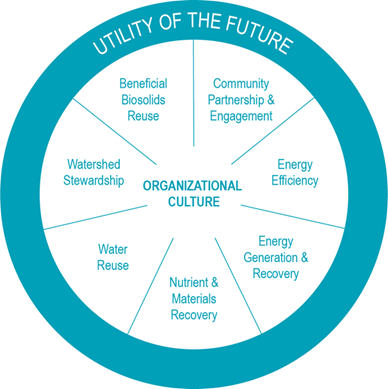The water and biosolids communities have been been looking forward to integrate organizational culture and water resource recovery to become a leader in sustainability. Specifically, wastewater treatment plants are transforming into water resource recovery facilities as a part of the Utilities of the Future program. Biosolids recycling contributes to the utilities’ greater goals. Beneficial biosolids reuse is one important pillar to energy sustainability, soil health and nutrient reuse.
The Water Environment Federation (WEF), along with its partners, the National Association of Clean Water Agencies (NACWA), the Water Research Foundation (WRF) and the WateReuse Association, with support from the Environmental Protection Agency (EPA), and the Department of Energy (DOE), has recognized 183 utilities as a part of the Utility of the Future Program, including two of our own, AlexandriaRenew (AlexRenew) and the Hampton Roads Sanitation District (HRSD).
Karen Pallansch is the CEO of Alexandria Renew. In a recent webinar, Karen spoke about AlexRenew’s values and the intention used in upgrading the Nitrogen Management Facility in 2016. Instead of simply meeting basic requirements, AlexRenew embraced its values and expanded upon the Chesapeake Bay requirements as well as designing the new building for LEED certification to promote sustainability.
Engaging with community partners is also a great focus of AlexRenew to provide education and stewardship for the entire community of Alexandria, where water and green space is at a premium. AlexRenew’s lobby enables educational opportunities for children of all ages; outdoor features include a fountain, irrigation and fish — all a reuse of its water. Reclamation projects continue with their neighboring cidery to re-use water and biosolids to grow their apple trees. Finally, water sampling and clean ups are just another way of partnering with groups to encourage and maintain the watershed.
You can find a past Words on Water WEF podcast where Pallansch discusses the Utility of the Future concept and specifically how AlexRenew embodies a Utility of the Future, particularly through its community engagement, watershed stewardship, and recovery of resources such as water, energy, and nutrients.
The Hampton Roads Sanitation District was honored as another Utility of the Future, recognizing HRSD for its exceptional performance and innovative and forward-thinking practices that are providing sustainable, efficient and value-added services to the region. Jay Bernas, Director of Finance, HRSD, highlighted the cultural change that lead to the all around success of the organization by developing a values-based strategic plan that focused value on people, environmental benefits, infrastructure, partnerships and operations. By supporting and embracing its people the organization’s leadership allowed for innovative brainstorming and development, resulting in successful projects such as the SWIFT project.
HRSD is truly committed to proudly working to protect public health and the waters of Hampton Roads so that future generations will inherit clean waterways and be able to keep them clean.
To further understand the benefits of the application of biosolids, Dr. Linda S. Lee, Professor of Agronomy, Purdue University, is engaging in research to address key gaps in understanding of the occurrence and fate of PFAS in rural landscapes and agricultural operations and their impacts on rural water supplies and agricultural products. This product of this research will assess PFAS fate, transport and crop uptake in two site-specific field studies – one involving spray-irrigation of effluent and the other involving land-applied biosolids, which also includes assessing if co-application at the field-scale of biosolids-based biochar or water treatment residuals with typical biosolids will reduce overall PFAS mobility. Jamie Heisig-Mitchell of HRSD, current President of VBC, said “This ongoing research is both timely and vital to providing a critical foundation of regulations to look to the future and guide beneficial use.”
